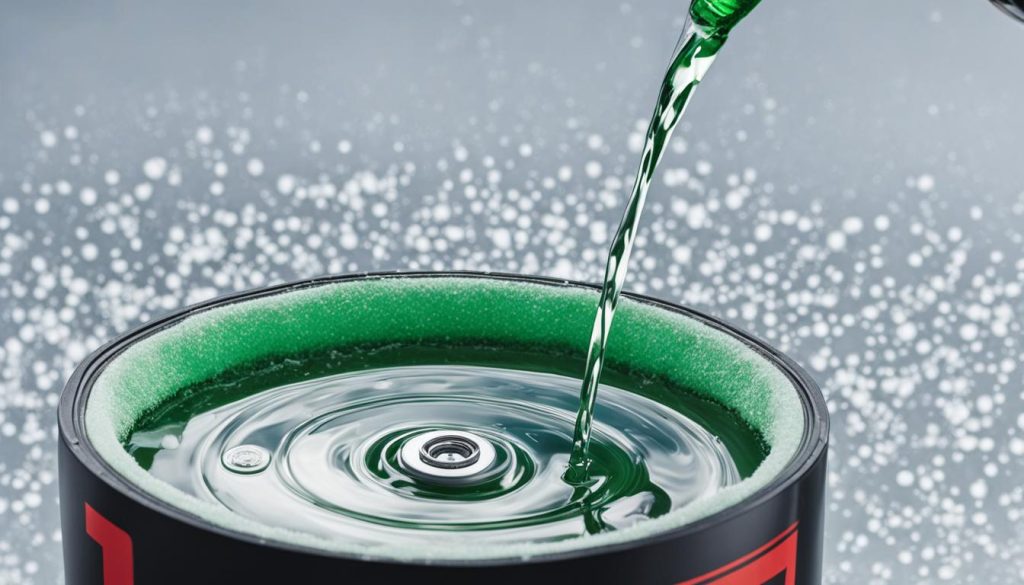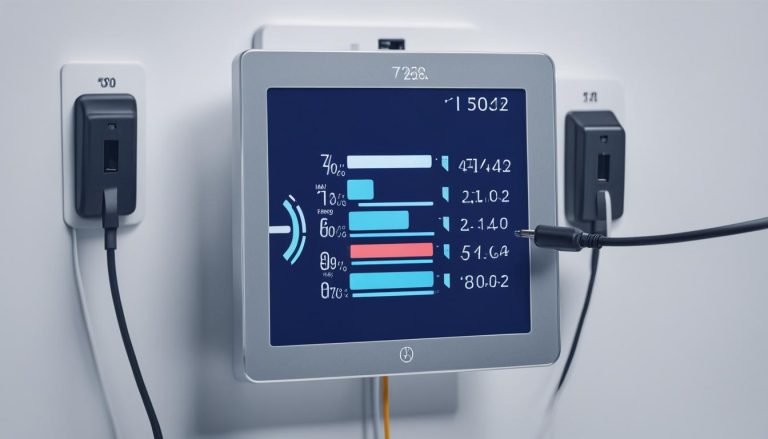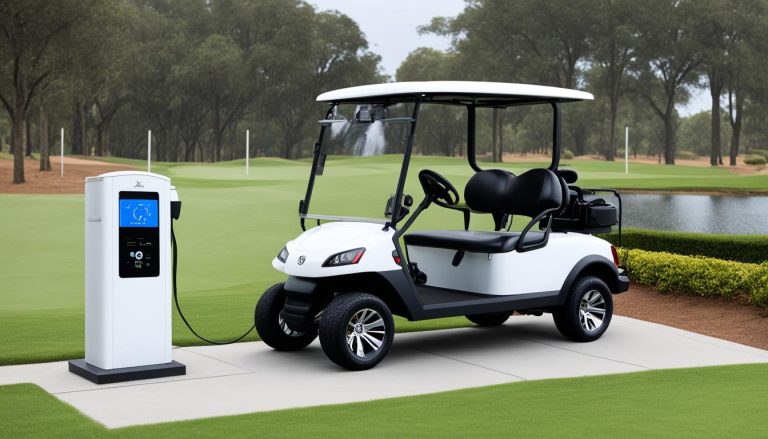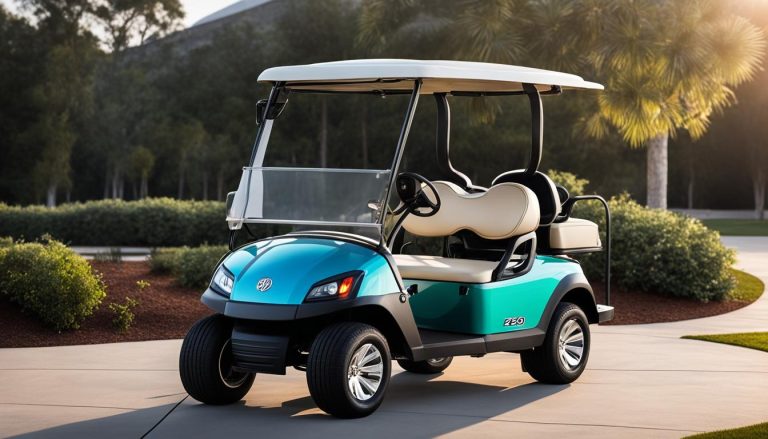Charging Golf Cart Batteries: Tips & How-To Guide
batterychargers.site and its partners may earn a commission if you purchase a product through one of our links
Proper maintenance and charging of golf cart batteries are crucial for maximizing their lifespan and performance. Whether you are a seasoned golfer or operate a golf course, knowing how to charge your golf cart batteries correctly can save you time, money, and potential headaches. In this guide, we will provide you with expert tips, best practices, and methods for charging your golf cart batteries effectively.
Key Takeaways:
- Charge your golf cart batteries after every use to ensure they are ready for your next round.
- Regularly water your batteries to maintain optimal performance.
- Invest in a quality charger to ensure efficient and safe charging.
- Avoid overcharging the batteries and using improper chargers to prevent damage.
- Keep your golf cart batteries away from freezing temperatures and excessive heat.
Essential Golf Cart Battery Charging Tips
Properly maintaining and charging your golf cart batteries is crucial for their longevity and performance. By following these essential tips, you can ensure that your batteries remain in top shape and provide reliable power for your golf cart.
Charge Your Batteries After Every Use
One of the most important tips for maintaining your golf cart batteries is to charge them after every use. Leaving your batteries in a discharged state for an extended period can cause sulfation, which reduces battery capacity and lifespan. To prevent this, make it a habit to charge your batteries immediately after each round of golf or any other use.
Water Your Batteries Regularly
Watering your golf cart batteries regularly is vital for their proper functioning. Most golf cart batteries are of the lead-acid type and require distilled water. Check the water levels in each cell and add water when necessary to maintain the recommended level, usually above the battery plates. Be careful not to overfill, as it can lead to electrolyte overflow.
Cleaning Batteries
Regularly cleaning your golf cart batteries is essential for their maintenance. Keep the battery terminals clean and free from corrosion by using a mixture of baking soda and water. Apply the mixture to the terminals, scrub gently with a brush, and rinse thoroughly with clean water. This prevents poor electrical connections and improves overall battery performance.
Buy a Quality Charger
Investing in a quality charger is a smart decision for the long-term health of your golf cart batteries. A reliable charger will provide a proper and efficient charge, preventing overcharging or undercharging, which can both be damaging to the batteries. Look for chargers with automatic shut-off features and multiple charging modes to cater to different battery types and requirements.
Incorporating these essential golf cart battery charging tips into your routine will help maximize the lifespan and performance of your batteries. Remember to charge your batteries after every use, water them regularly, clean the terminals, and invest in a quality charger for optimal results.
Things to Avoid When Charging Golf Cart Batteries
When it comes to charging your golf cart batteries, there are several common mistakes that you should avoid. By being aware of these pitfalls, you can ensure the longevity and optimal performance of your batteries.
- Overcharging Batteries: Overcharging your batteries can lead to excessive heat buildup and damage the battery cells, ultimately shortening their lifespan. It is important to follow the manufacturer’s recommended charging guidelines and avoid leaving the batteries connected to the charger for extended periods.
- Use of Improper Charger: Using the wrong charger can have detrimental effects on your golf cart batteries. Always make sure to use a charger specifically designed for your battery type and model. Using a charger with incorrect voltage or charging capacity can result in undercharging or overcharging, leading to battery failure.
- Exposing Batteries to Extreme Temperatures: Extreme temperatures, such as freezing locations or direct heat, can negatively impact the performance and lifespan of your batteries. It is crucial to store and charge your golf cart in a moderate temperature environment to avoid excessive stress on the battery cells.
- Leaving Accessories On: Leaving accessories, such as lights or radios, turned on while the golf cart is not in use can drain the battery power. This can lead to deep discharge, reducing the battery’s capacity and overall lifespan. Always remember to turn off any unnecessary accessories when not using the golf cart.
- Driving Until It Dies: Continuously driving the golf cart until the battery dies completely can be harmful to the battery’s health. It is recommended to recharge the batteries before they are fully depleted to avoid deep discharging, which can negatively impact the battery’s capacity and longevity.
- Riding on Steep Hills: Riding on steep hills puts additional strain on the golf cart’s batteries, causing them to work harder and drain faster. If possible, avoid driving on steep terrain or limit it to a minimum to prevent excessive stress on the batteries.
- Leaving the Golf Cart Inactive: Leaving your golf cart inactive for extended periods without proper maintenance and charging can lead to battery deterioration. It is important to keep the batteries charged and periodically check their voltage to ensure they remain in good condition, even during periods of inactivity.
By avoiding these common mistakes, you can maximize the lifespan and performance of your golf cart batteries, ensuring many enjoyable rides ahead. Remember to always follow the manufacturer’s recommendations and take proactive steps to maintain your batteries for years to come.
Important Factors to Remember
When it comes to maintaining your golf cart batteries, there are a few important factors you need to keep in mind:
- Use Distilled Water: When watering your batteries, always use distilled water instead of tap water. Distilled water is free from impurities and minerals that can damage the battery’s cells and reduce performance.
- Monitor the Water Filling Level: Regularly check the water filling level of your batteries. It’s crucial to maintain the right water level to ensure proper battery function. If the water level is too low, the plates can be exposed to air, leading to corrosion and decreased battery life.
- Keep the Plates Safe: The battery plates are delicate and need to be protected from open air exposure. Keep the battery caps securely tightened to prevent the plates from drying out and forming sulfate deposits. These deposits can hinder the battery’s ability to hold a charge.
By following these important factors, you can improve the overall performance and lifespan of your golf cart batteries. Remember, proper maintenance is key to maximizing the efficiency of your batteries and enjoying a longer lifespan.

When to Replace Golf Cart Batteries
Proper care and maintenance can significantly extend the lifespan of golf cart batteries. Typically, these batteries last for 4 to 5 years with regular usage. However, it’s important to be aware of certain signs that may indicate the need for replacement.
One of the key signs to watch out for is reduced battery capacity. If you notice that your golf cart is not running for as long as it used to on a single charge, it could be an indication that the batteries are reaching the end of their lifespan.
Swelling or leakage of the battery is another red flag. If you observe any bulging or corrosion on the battery casing, it’s a clear sign that the batteries need to be replaced. Additionally, shortened run time, where the battery cannot sustain the usual distance or speed, is another indicator of battery degradation.
Monitoring the voltage readings can also provide insight into the health of your golf cart batteries. If you consistently notice low or uneven voltage readings, it may be time to consider replacing the batteries.
Remember, regular maintenance and adherence to charging best practices are essential for maximizing the lifespan of your golf cart batteries. By keeping a close eye on these signs and promptly replacing worn-out batteries, you can ensure optimal performance and prolonged enjoyment of your golf cart.
FAQ
How often should I charge my golf cart batteries?
It is important to charge your golf cart batteries after every use to ensure optimal performance and longevity.
Do I need to water my golf cart batteries?
Yes, regular watering is crucial for maintaining your golf cart batteries. Use distilled water and monitor the water filling level regularly.
How should I clean my golf cart batteries?
Cleaning your golf cart batteries regularly is important. Use a mild detergent and water solution to clean the battery terminals and remove any dirt or corrosion.
What type of charger should I use for my golf cart batteries?
Invest in a quality charger specifically designed for golf cart batteries. Using the wrong charger can cause damage and reduce the lifespan of the batteries.
What are the common mistakes to avoid when charging golf cart batteries?
Avoid overcharging the batteries, exposing them to extreme temperatures, leaving accessories on for extended periods, driving on steep hills, and letting the batteries drain completely.
How can I maximize the lifespan of my golf cart batteries?
Use distilled water for watering, keep an eye on the water filling level, protect the plates from open air exposure, and follow proper charging and maintenance practices.
How long do golf cart batteries typically last?
Golf cart batteries typically last around 4 to 5 years, but this can vary depending on usage and maintenance. Signs of reduced capacity, swelling, leakage, shortened run time, or low and uneven voltage readings may indicate the need for replacement.






